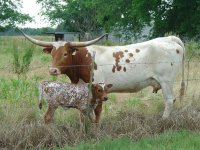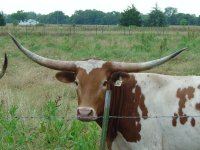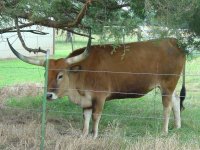Report: US Cattle Herd at Lowest Number Since 1951 - ABC News
http://www.ams.usda.gov/mnreports/tv_ls140.txt
They are just too high to buy! I have been getting all the ducks in a row for about three years. I have my pastures fenced and cross fenced. I ran water lines to the most remote fields/pastures. I built a small sorting pen with a working chute and a head gate. I have some pretty good native grass pastures. I have clover, vetch, wild ryegrass, supplemented with some small grains like wheat and rye for winter grazing, and some bermudagrass with plantings of millet for summer grazing. I have a pretty fair stock trailer that I'm putting a new floor in. I have a good tractor to keep the weeds mowed and all the other chores a tractor is useful for. The only thing I don't have is cows.
I don't want a large herd, just a "hobby herd," maybe a dozen mama cows. Usually, beef prices run in cycles. They get cheap, and ranchers stop holding back breeding stock. Then, supply drops off, prices go up, ranchers hold back even more breeding stock, and prices go higher. Eventually, the increased breeding herd results in increased supply, and on and on. There are, of course, other factors, the drought out west being an example, and the use of corn for ethanol another. The recently released report by the Ag Statistics Service says the herd is it at its lowest number since 1951. They speak of a seven year herd contraction. As a result, prices are high. I have been waiting for prices to go down, but they ain't. They aren't going to any time soon, either.
What I would like to do is find a small herd, say maybe eight or ten cows, with maybe four or five calves. Hopefully the mamas without a calf would be bred and due to drop a calf in the next two months or so. I could graze 300 lb calves on some fine winter/spring grazing for a couple of months, sell them to recoup some of the investment, and put a bull on the mamas. Or, I could start going to a couple of sale barns within 25 to 40 miles and see what I can buy through the auction ring. That's what I will probably wind up doing. One can sometimes make some money off someone else's mismanagement by buying cows in poor condition and feeding them back to good condition on good grass.
No matter how I do it, it is going to cost more than I want to pay, but I think I'm going to bite the bullet.
This picture was made in late February, either last year or the year before. The grass is mostly wild rye grass. It had no fertilizer on it. It would have been some lush grazing for some calves, especially if it had been fortified with a little 15-0-15.

http://www.ams.usda.gov/mnreports/tv_ls140.txt
They are just too high to buy! I have been getting all the ducks in a row for about three years. I have my pastures fenced and cross fenced. I ran water lines to the most remote fields/pastures. I built a small sorting pen with a working chute and a head gate. I have some pretty good native grass pastures. I have clover, vetch, wild ryegrass, supplemented with some small grains like wheat and rye for winter grazing, and some bermudagrass with plantings of millet for summer grazing. I have a pretty fair stock trailer that I'm putting a new floor in. I have a good tractor to keep the weeds mowed and all the other chores a tractor is useful for. The only thing I don't have is cows.
I don't want a large herd, just a "hobby herd," maybe a dozen mama cows. Usually, beef prices run in cycles. They get cheap, and ranchers stop holding back breeding stock. Then, supply drops off, prices go up, ranchers hold back even more breeding stock, and prices go higher. Eventually, the increased breeding herd results in increased supply, and on and on. There are, of course, other factors, the drought out west being an example, and the use of corn for ethanol another. The recently released report by the Ag Statistics Service says the herd is it at its lowest number since 1951. They speak of a seven year herd contraction. As a result, prices are high. I have been waiting for prices to go down, but they ain't. They aren't going to any time soon, either.
What I would like to do is find a small herd, say maybe eight or ten cows, with maybe four or five calves. Hopefully the mamas without a calf would be bred and due to drop a calf in the next two months or so. I could graze 300 lb calves on some fine winter/spring grazing for a couple of months, sell them to recoup some of the investment, and put a bull on the mamas. Or, I could start going to a couple of sale barns within 25 to 40 miles and see what I can buy through the auction ring. That's what I will probably wind up doing. One can sometimes make some money off someone else's mismanagement by buying cows in poor condition and feeding them back to good condition on good grass.
No matter how I do it, it is going to cost more than I want to pay, but I think I'm going to bite the bullet.
This picture was made in late February, either last year or the year before. The grass is mostly wild rye grass. It had no fertilizer on it. It would have been some lush grazing for some calves, especially if it had been fortified with a little 15-0-15.






